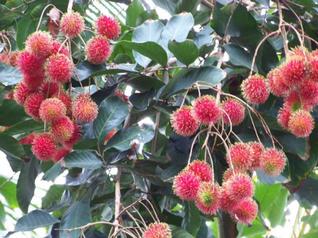
The rambutan (Nephelium lappaceum)Family:
Sapindaceae Other names:
Hairy lychee is a medium-sized tropical
tree probably native to Southeast Asia, although its precise natural
distribution is unknown. It is closely related to several other edible
tropical fruits including the Lychee, Longan and Mamoncillo. Rambutan in Indonesian of Malay literally means hairy or hairy fruit
caused by the ‘hair’ that covers this fruit. Rambutans are most
commonly eaten out-of-hand after merely tearing the rind open, or
cutting it around the middle and pulling it off. It does not cling to
the flesh. The peeled fruits are occasionally stewed as dessert. In
Malaya a preserve is made by first boiling the peeled fruit to separate
the flesh from the seeds.
The Rambutan fruit is sold at Rs 60 to Rs 80 per kg. In cities, it is
sold at Rs 250 per kg. The transportation of the fruit is easy as it
will not spoil even after a week.
This fruit resembles litchi, except for its long, flesh coloured spines.
It’s eaten after opening the rind or cutting it around the middle and
tearing it apart. The rind does not cling to the flesh which is pearly
white, juicy and sweet with a sub-acid flavour. There is a single seed
inside. The flowering of the tree occurs from June and the fruits mature
from June to September. A tree bears fruit for 30 years. One can get
nearly one quintal fruit from a tree in a year. Fresh Rambutan contains a
substantial amount of Vitamin C and B
Lychee is popular as one of the kings of tropical fruit and has a very
long history in Asia. The fruits are very attractive, with bright red
skin covered by angular or conical protuberances. The fruit Longan
resembles lychee, but the fruits are smaller, smoother, yellow-tan to
brown, milder in flavor and less acidic. Rambutan and pulasan are also
similar to lychee, with red or yellow skin, however, long hairs or
spinterns replace the protuberances.
Clones of two varieties of litchi brought from Vietnam, namely Rambutan
and Logan, are being experimented with to enhance the quality of the
litchis. Flowers of these varieties have started blooming and it is
expected the fruits would be big.
No comments:
Post a Comment